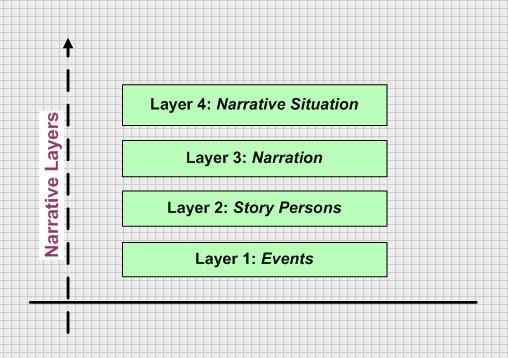Trending
Opinion: How will Project 2025 impact game developers?
The Heritage Foundation's manifesto for the possible next administration could do great harm to many, including large portions of the game development community.
In this article I continue my analyses on reward structures and narrative layers.

In my previous article I had a look at how narrative bits in Diablo and Tetris are combined with reward schedules. In this article I will broaden the scope of analyses towards the story persons layer and see how the relation between narrative and rewards works beyond the core functions level. This time we will be only dealing with Diablo.
Narrative Layers and the Creation of Meaning
Earlier in an article, I identified four types of interaction. The article followed the classical model of narrative layers in narratology. Here is a diagram showing those narrative layers:

Four Layers of Narrative
The classical structural analyses of narratives utilizes a linguistic model which identifies various layers of language elements aligned on a vertical axis. It's the vertical relationship through which meaning in language is achieved. The vertical relationship basically works as a synthesis between layers. Meanings are the result of the growing synthesis from the first language layer (letters) towards the upper language layers (words, sentences):
[Letters form words form sentences.]
A similar synthesis works in narratives. For example the elements on the events layer gain their ultimate meaning and significance through how they connect to the story persons layer. The story persons in the story persons layer gain their ultimate meaning and significance through how they are connected to the narration layer. Finally, all this construct of layers ultimately gains its meaning through its embeddedness into the narrative situation.
Traversing a narrative is not only to move from the beginning to the end of the story (moving horizontally), but it also means movement throughout the various interconnected layers (vertical movement). To give an example: being rewarded with that sword can feel so cool because this single event (earning the sword) might express meaning not only on the events layer, but also on the story persons layer.
Making a Reward Work Over Multiple Narrative Layers
Let us have a brief look at Diablo to understand how rewards interact with the various layers of the game's narrative. Consider the following diagram:

Reward and narrative layers in Diablo
First and foremost, the reward mechanic is triggered on the ground layer of the narrative, the Events layer. The player is busy carrying out core functions (like killing monsters). On (successful) completion of the task (monster killed), the underlying reward mechanism will usually spawn gold, and in rarer cases a magical item. In addition to this, the character will also receive experience points.
When we speak of experience points, however, we have already stepped over to another narrative layer, that of the story person (or character). Having a closer look at the impact of the reward, we see that it does not only reward our success on the events layer, but that it also plays a central role in character growth: While experience points will contribute to develop the skill set of the character, magical items and gold enrich the character's inventory.
Diablo does not feature a backstory in regard to player-controlled characters, hence character development is mostly limited with the "to do" side of the character (the skills and abilities that she possesses). Other games reward players with information about the characters past and the unknown sides of her personality, the "to be" of the character. Hence these might feel a bit richer or deeper than the "to do"-oriented games.

Character Growth
Yet dealing with the past or the inner world of the character are optional elements in storytelling and Diablo remains fully functional although it limits character growth mostly to skills and abilities.
Conclusion
In this article I had a look at how rewards in the game Diablo worked over multiple narrative layers. While rewards where given out for the completion of tasks on the events layer and hence felt like belonging to the immediate and event-dense experience of battle, they also worked on a broader sense and connected to the story persons layer in order to maintain character growth. The analyses concluded that Diablo's reward structure mostly contributed to the "to do" side of the character. However, it was explained that for example through giving rewards based on backstory information of the character, it was always possible to also support the "to be" side in character development.
Read more about:
BlogsYou May Also Like